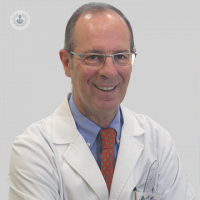Knee injuries in winter sports
Written by:Many winter sports are related to a strong support of the foot to the ski through the boot and the fixation. As in most of the serious pathologies of the knee, the most important thing is the prevention to avoid them and in this sense to get before the season to be with a minimum of strength and elasticity is highly recommended. The practice of quadriceps exercises, or cycling, and practice a hamstring and anterior rectus stretching sessions will put us in shape.
Most injuries are due to three reasons:
1. Overload injuries
Overload injuries: The forced position of the knee in semi-flexion places the extensor system in permanent tension, which can cause pain in the anterior side due to suffering from the cartilage of the patella (chondromalacia in unfortunate term). This same position is used for the practice of Snowboarding.
It also suffers from the patellar tendon and the quadriceps tendon to cushion the bending forces that are transmitted through the knee.
2. Injuries from direct trauma
Injuries from direct trauma: Usually on the anterior aspect of the knee and can cause either a fracture of the patella or an injury to the posterior cruciate ligament by direct blow against the anterior tibial tuberosity.

3. Torsion injuries
Torsional injuries are frequently more serious and can be summarized in three:
Injury of the anterior cruciate ligament, injury of the internal lateral ligament and meniscal injury.
The mechanism of injury is different depending on the placement of the body and the direction of the force. With the forced valgus mechanism, the ski with the leg, are opened, causing the injury of the internal lateral ligament in different degrees depending on the intensity of the force. If it persists, injury to the anterior cruciate ligament occurs, which is often accompanied by a meniscal lesion that is the feared unfortunate triad of O'Donoghuei.
The rupture of the anterior cruciate ligament is the most frequent of the serious injuries. The mechanism can be with the unbalanced body turned backwards, in this case it is the quadriceps itself trying to maintain the static of the body that breaks it by forcing excessively the anterior translation of the tibia. The other mechanism is the fall forward leaving the foot fixed in internal rotation.
The diagnosis of this lesion is made clinically with the Lachman test and the presence of the so-called dynamic tests. With these two tests also confirmed by the measurement of the previous drawer with the KT 1000, the diagnosis of certainty is made, leaving the RX and Resonance to confirm the injury and assessment of accompanying injuries.
The treatment of the injury of the internal lateral ligament is always conservative, it is enough to immobilize the knee, but starting very soon the functional rehabilitation so that the knee while it heals is gaining mobility.
The treatment of the cruciate ligament injury in young patients with sports aspirations is always surgical replacing the torn ligament with a plasty, either with hamstring tendons (semitendinosus and gracilis), or with the middle third of the patellar tendon. In both techniques the treatment is always arthroscopic since with this technique the precision for the placement of the tunnels both in the femur and in the tibia is maximum. The same technique allows the evaluation of meniscal injuries as well as their repair.


